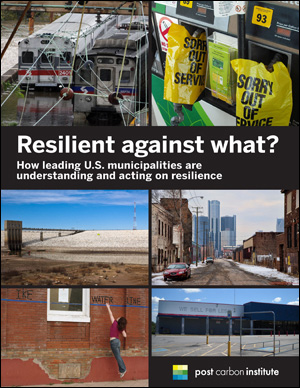
Resilient Against What?
October 16, 2013
Resilience is often understood simply as the ability to “bounce back” from a single disaster like a hurricane or earthquake. This survey commissioned by Post Carbon Institute found that leading US municipalities already have a much more sophisticated understanding of resilience involving economic, energy, and social challenges—and they’re putting it into action through policies, regulations, and programs.
Report Authors: Jim Thayer, Morgan Rider, Daniel Lerch
See also our follow-up report, Six Foundations for Building Community Resilience (2015).
Read the report here
Executive Summary
Over the last fifteen years, many US municipalities have set sustainability goals and implemented policies and programs to achieve them. More recently, resilience has emerged as an additional goal of some municipalities, particularly in the wake of extreme weather events like Hurricane Sandy and major economic disruptions like the Great Recession.
This study explored how some municipalities that are already leading the way on sustainability are now understanding and applying the concept of resilience. Senior staff at fourteen selected municipalities of various regions and sizes were surveyed on their communities’ perceived risks and vulnerabilities, and how these were being addressed. Five major conclusions were derived from the responses, some of which run counter to the “conventional wisdom” on resilience:
- While “resilience” is interpreted many ways, it is largely understood by these sustainability leaders to have a scope greater than mere disaster preparedness. This stands in contrast to the current public conversation on resilience in urban planning and policy circles (and increasingly in popular media and politics), where concerns about climate change and natural disasters generally dominate.
- Resilience-building is already regarded as an important part of these communities’ ability to deliver services, although respondents ascribed different specific activities to it. This was unexpected as resilience has not been a significant topic in local public policy and planning until only very recently.
- Lack of time and lack of resources are seen as the biggest barriers to resilience-building actions, not necessarily a lack of public or government awareness. Budgetary constraints also had a direct impact on the pace of adoption of relevant initiatives.
- Citizen pressure is a major influence on resilience-building actions. Citizens understand the need for greater resilience and want actions to enhance it.
- Neither national nor local regulations are seen as significantly hindering community resilience-building actions. Changes in local regulations are, in fact, pushing adoption of resilience-building approaches more than federal regulations.
These findings suggest that efforts to encourage resilience-building in all U.S. communities should:
- Reach beyond disaster preparedness and basic awareness-raising.
- Identify and work with local government officials, agencies, and staff—as well as community leaders and stakeholders—who are already engaged in resilience-building.
- Prioritize the need for dedicating resources.
- Recognize the value of local leadership and policymaking.
- Look to and learn from the experiences of those communities in the vanguard of building resilience.
